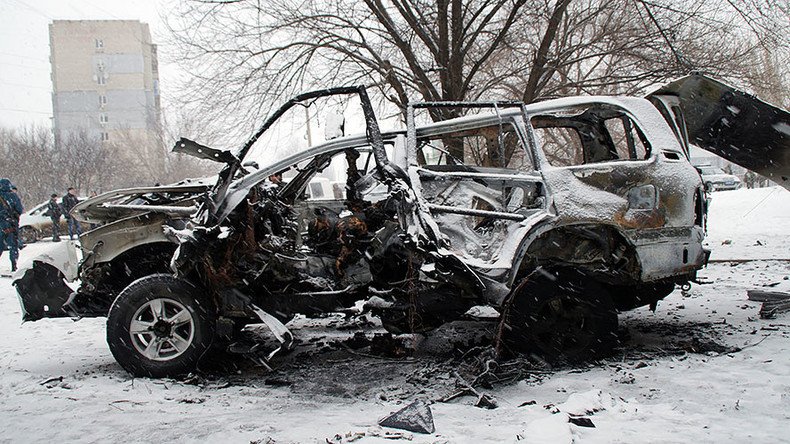Two people, including the chief of the Lugansk People's Republic (LPR) Militia Office, were killed in a car blast in the republic’s capital, Lugansk. The Lugansk People’s Militia says the blast was a terrorist attack carried out by Kiev’s secret services.
“The chief of the LPR People's Militia Office, Colonel Oleg Anashchenko, has died today in a terror act,” Major Andrey Marochko, the department’s representative, said at a press briefing on Saturday, as cited by RIA Novosti news agency.
“Presumably, the terror attack was committed by Ukrainian special services aiming to destabilize the situation in the republic [of Lugansk],” Marochko added.
He stressed, however, that despite this incident, “Kiev’s hit squad will not be able to break the morale of the fighters of the People's Militia,” adding that Lugansk authorities have launched an investigation and will “punish the masterminds and those responsible for carrying out this heinous act of terrorism.”
The blast occurred at about 8am local time. The People's Militia press service earlier said that the car belonged to Oleg Anashchenko. According to the office of the Lugansk Attorney General, Anashchenko was the only person in the car at the time of the explosion.
READ MORE: Kiev’s ‘barbaric’ attack on Donetsk in E. Ukraine violates Geneva convention – Russia
“During the inspection of the crime scene we found out that only one person was in the car – Oleg Anaschenko himself. We've also established that the blast occurred on the driver's side of the vehicle. The type and nature of the explosive devices is currently investigated,” David Kats, the Lugansk Attorney General press secretary said at a press briefing on Saturday.
The situation in Donbass, an area in eastern Ukraine that includes the Lugansk and Donetsk Republics, has severely deteriorated over the past several days, with fighting between Kiev forces and the troops of the Donetsk People’s Republic (DPR) intensifying near the town of Avdeevka in the Donetsk region.
Earlier this week, Ukraine officially acknowledged that its troops began a slow advance on rebel positions in eastern Ukraine. Igor Pavlovsky, Ukraine’s deputy defense minister, however, told the Ukrainian media that the step was provoked by actions from anti-Kiev forces.
On Thursday, the OSCE monitoring mission in eastern Ukraine published a damning report, claiming there had been a significant increase in ceasefire violations recorded in both the Donetsk and Lugansk regions. The OSCE also documented the widespread use of multiple-launch rocket systems in Avdeevka, Yasynuvata, and Horlivka, with at least 10,330 explosions recorded within the past several days.
According to investigators, the Ukrainian military, acting on the orders of senior commanders and officials from the Ukrainian Defense Ministry, conducted heavy artillery attacks on several residential areas of the city of Donetsk and the suburban towns of Yasinovataya and Makeyevka on February 1, 2, and 3 this year. Three civilians died and 15 were wounded as a result of the shelling.
The attacks also damaged at least 60 residential buildings and civilian infrastructure facilities.
The OSCE mission, however, claims both sides have been responsible for the suffering of local residents.
Over 30 people were killed and more than 80 others, including 47 civilians, were injured in the DPR as a result of the violence so far this year, the republic’s Ombudsman’s Office spokesman said on Friday, as cited by Sputnik News.
The conflict in Ukraine’s Donbass began back in 2014, when people in Donetsk and Lugansk rejected the armed coup in Kiev, which saw then-President Viktor Yanukovich ousted and Petro Poroshenko's government installed. The new government eventually launched a military crackdown in eastern Ukraine, which led to a bloody conflict that has claimed over 10,000 lives to date, according to UN figures.
In February 2015, Kiev and authorities of the self-proclaimed republics signed a peace agreement in Minsk, known as the Minsk Accords. It stipulates a full ceasefire, heavy weapons withdrawal from the military contact line in Donbass, and constitutional reforms that would give both the LPR and DPR greater autonomy and special status.

